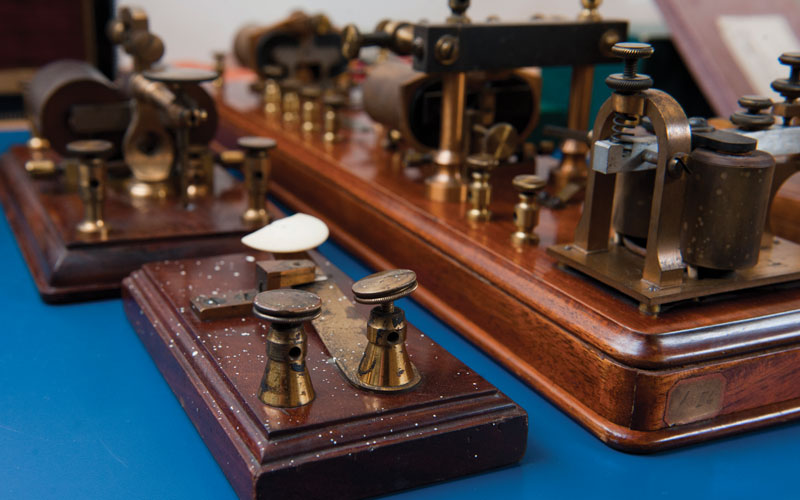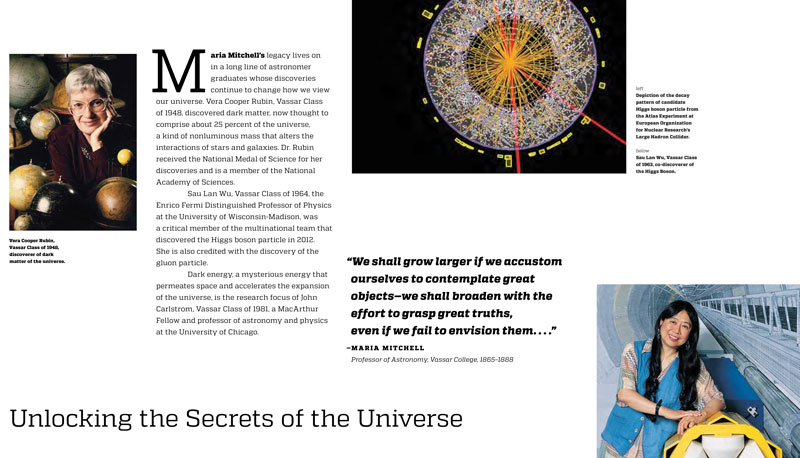Saving the Artifacts of Science

What began nearly five years ago with a casual conversation on a bus has blossomed into a celebration of 150 years of scientific achievements. Teaching tools, photographs, and stories chronicling Vassar's rich history as a leader in virtually all fields of science will be on display in the college's four science buildings.
Among the displays will be three early telegraph machines, one of which is believed to have been donated to Vassar by Samuel F.B. Morse, an early trustee of the college; a stuffed cane toad, brought back from South America in 1872 by James Orton, who chaired Vassar’s Natural History Department from 1869 until his death in 1877, while on another South American expedition; an “astro globe” that depicts all of the constellations in the night sky—used as a teaching tool by renowned 19th-century astronomer Maria Mitchell; and fossils collected by geology students on a field trip to South Dakota in 1896.
These priceless artifacts and hundreds more are displayed along with panels of explanatory texts and photographs in the four buildings that comprise Vassar’s Integrated Science Commons. This remarkable endeavor has been dubbed the Vassar College Artifacts Project (VCAP).
The work of some of Vassar’s superstars of science—Orton, Mitchell, ecologist Edith Roberts, astronomers Vera Cooper Rubin ’48 and John Carlstrom ’80, and physicist Sau Lan Wu ’63—will be spotlighted in comprehensive displays in the new Bridge for Laboratory Sciences, which opened in January. Other artifacts and displays will grace the walls of recently renovated New England Building, Olmsted Hall, and Sanders Physics.
The idea for VCAP was born in the spring of 2011 as biology professor Kate Susman and then-college historian Elizabeth Adams Daniels ’41 were sitting together on a bus that was heading to New York for a celebration to honor the college’s 150th anniversary. “I was telling Betty I was afraid a lot of our old science equipment would be discarded when the buildings were renovated,” Susman recalls. “I said someone should try to save the things that ought to be saved so we could pay tribute to Vassar’s science legacy. Betty said to me, ‘Just do it.’”
Over a two-year period, Susman, a group of dedicated student workers, and Rick Jones—a science illustrator, lab technician in Earth Science and Geography, and collections manager for Vassar’s Warthin Museum of Natural History— combed through the attics, closets, and hallways in Mudd Chemistry, New England, Sanders Physics, and Olmsted, laboriously figuring out what should be saved and how it should be displayed. Susman and Jones gathered stories, images, and artifacts from all over campus and shaped them to reflect a diverse story of the sciences as taught at Vassar. And the VCAP committee met regularly with Manhattan exhibit designer Richard Poulin and his team at Poulin + Morris to bring the project to fruition.

Now that the displays are complete, Susman says the project was well worth the effort. “It’s been a labor of love,” she says. “We’re all indebted to Betty and to [current college historian] Colton Johnson for their support.”
Jones calls the displays “sort of a 3-D version of the Vassar encyclopedia, a way for current students and their families and prospective students and visitors to see what Vassar has been doing in the sciences for the past 150 years.”
Marianne Begemann, dean of strategic planning and academic resources, says the new displays will help everyone at the college more fully appreciate Vassar’s science legacies. “Not only do the displays honor the groundbreaking work of Vassar faculty and alums, but they provide a way for current faculty and students to reflect on their own work in a broader historical and theoretical context,” Begemann says.
Two students who worked on the project, Mary Lesher ’16 and Miranda Kay ’17, say they gained a greater understanding and appreciation of Vassar’s contributions to science.
“I have been involved in the project from the original proposal; to the first ideas and themes; to tracking down sources, pictures, and objects for the exhibitions; to plans that we can hold in our hands; and now to the final product about to hit the shelves,” says Lesher, a history major from Wisconsin.

Lesher, who finds Maria Mitchell “incredibly inspiring,” says, “The first time I held her celestial globe, I was completely in awe. And as someone who works primarily in the humanities, I’ve learned so much about the sciences and all the technology involved in that realm.”
Kay, an earth science major from Connecticut, was involved in photographing and cataloging the artifacts, and she assisted with taxidermy maintenance and the restoration of many objects that had been in storage for decades. “What is particularly interesting to me is the way in which teaching models have evolved and changed through time,” she says. “These beautiful handmade, wooden, papier-mâché, and even wax models were replaced by equally impressive plastic ones. Today, many models are best conveyed through computer programs, which are incredibly useful but lack the physical craftsmanship evident in these older models.”
Jones says the displays will be updated to include future accomplishments by Vassar faculty and alums. “This project won’t be static; we have plans for keeping it up to date,” he says.
Susman says she hopes and expects that this project, which focused on the sciences, would be duplicated for other fields of study at Vassar. “From now on,” she says, “every time we renovate a building, we should do something like this.”
